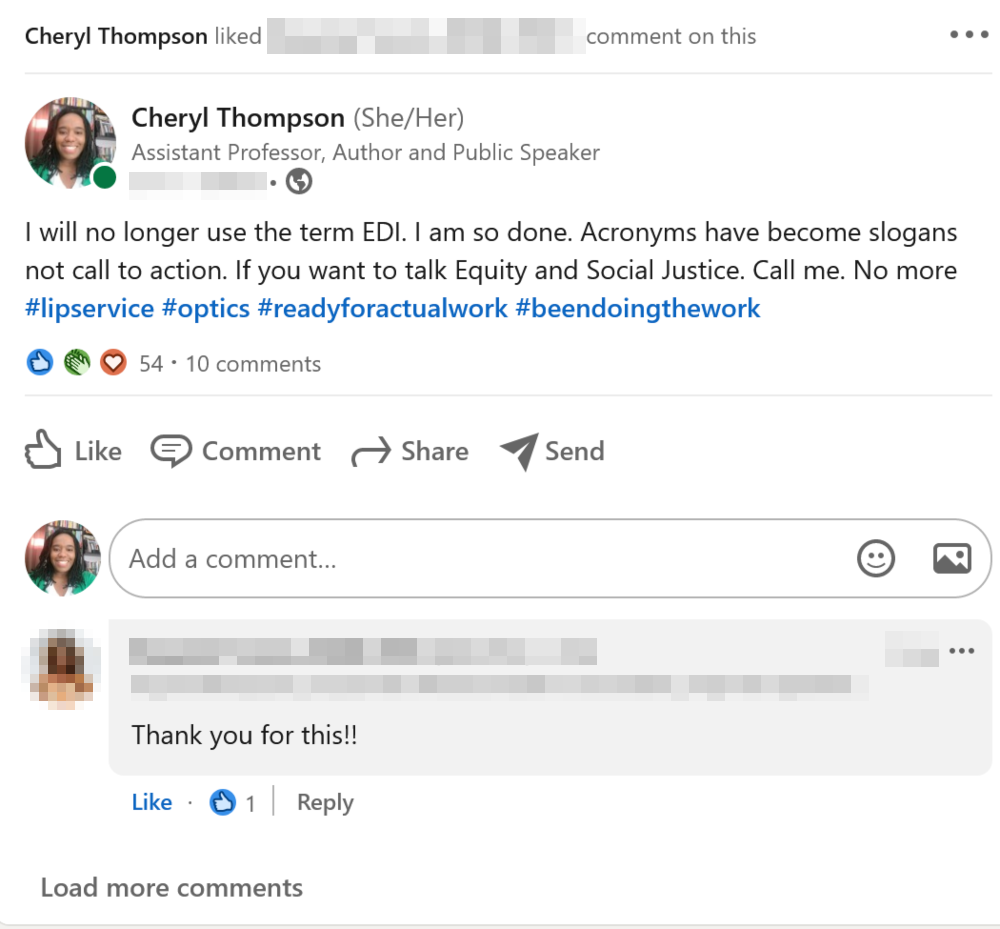Ditching “Diversity”: Why It’s Time to Replace Diversity with Belonging in Equity and Inclusion Work
by Dr. Cheryl Thompson | September 8, 2021 9:00 AM

In 2020, ‘EDI’ work grew exponentially in response to what appeared to be a global reckoning on anti-Black racism. This included conducting surveys, holding training sessions, and creating new EDI positions that prior to the murder of George Floyd did not exist.
Equity is defined as redistributing benefits and removing burdens so that all individuals and groups have access to the same opportunities; Diversity is understood as embracing differences – racial and ethnic, linguistic, sexual orientation, etc.; and Inclusion, like equity, is a structural concept that aims to support equal access to opportunities and resources for people who might otherwise be excluded or marginalized.
The first time I heard the acronym ‘EDI’ was in 2018. During my graduate studies, there were rarely any conversations about equity and inclusion. I remember asking someone what ‘EDI’ stood for and when they told me, I thought it was problematic to collapse these concepts into a quick shorthand without any discussion about what each term actually means. ‘EDI’ is not a catchphrase; it is supposed to be actionable. While acronyms are vitally important to fostering creativity and innovation, many people either do not do their work to understand what each word means, or blatantly resist its call-to-action. When I posted on my Linkedin page that: “…Acronyms have become slogans not a call to action. If you want to talk Equity and Social Justice. Call me. No more #lipservice #optics #readyforactualwork #beendoingthework,”; Many people agreed. 
Don’t get me wrong, the likes of Dr. Malinda Smith, Vice-Provost (Equity, Diversity and Inclusion) at the University of Calgary, and of course, my colleague Dr. Denise O’Neil Green, Vice-President, Equity and Community Inclusion, X University (Note: X University, currently known as Ryerson University is changing its name after receiving the Standing Strong taskforce report that has 22 recommendations, including to rename the University), have been doing great work in this area for well over two decades. In the 1990s in Canada, the term “multicultural” was often used to signal diversity and inclusion. In fact, following the passing of the Multicultural Act in 1988, Canada was rebranded as “multicultural” and many companies began to tout diversity and inclusion not singularly as an ethos but as a brand. Today, multicultural marketing is big business. But beyond the image-making and representation, there is a lot of virtue signaling around EDI but the commitments to advance equity and inclusion practices often fall short.
We love acronyms because they are a heuristic, a mental shortcut for quick decision-making. They also look great in branded materials, but for acronyms to have value they must be actionable. Every word must not only stand for something but also lead to something. Equity and inclusion have concrete aims, but diversity programs often fail because they’re viewed as “nice to do” but not imperative and necessary for productivity, social inclusion, and accountability. Additionally, diversity programs rarely aim to create a shared meaning of diversity, but instead they remain narrowly defined through a Eurocentric lens, oftentimes with women being the primary form of diversity that is important. For that reason, I believe that we could look to replace “diversity” with a more actionable term that has, at its core, shared meaning.
Instead of “diversity”, what if we added “belonging” to equity and inclusion. Belonging is about fostering friendships, trust, and acceptance – all the things you hope to experience in your personal and professional life. As Medium Blogger and Innovation Coach Krys Burnette put it: “Belonging is the outcome of holding space where everyone truly feels empowered to speak up, make change, and shift the culture”. There are also tangible methods for measuring employee belongingness, which start by asking the basic question: “How well do you feel you belong at your workplace?”.
A discourse on Belonging will challenge complacency; it will engender listening to people who have, historically, been marginalized, and pinpoint what we can do to change systems and structures. If we can all agree on one thing: It’s that we all want to belong!
The language around equity and inclusion is so heavy and, in my opinion, has for too long focused on structural changes while not paying attention to actual people right in front of us. People respond to simple language. That’s why Nike is so successful. “Just Do It” is simple. If we actually asked co-workers if they felt a sense of belonging, I think the results would completely shock people, especially those who have been doing EDI work. People don’t change because of systems and structures; systems and structures engender shifts in people’s consciousness around issues. But change is interpersonal for me, it happens when you are personally impacted by the issues. I’m trying to start a conversation where we make this personal; not obtuse, distant, and most of all, not institutional. So I ask: How can we make belonging practical and personal?
Source URL: https://institutionaldiversityblog.com/ditching-diversity-why-its-time-to-replace-diversity-with-belonging-in-equity-and-inclusion-work/